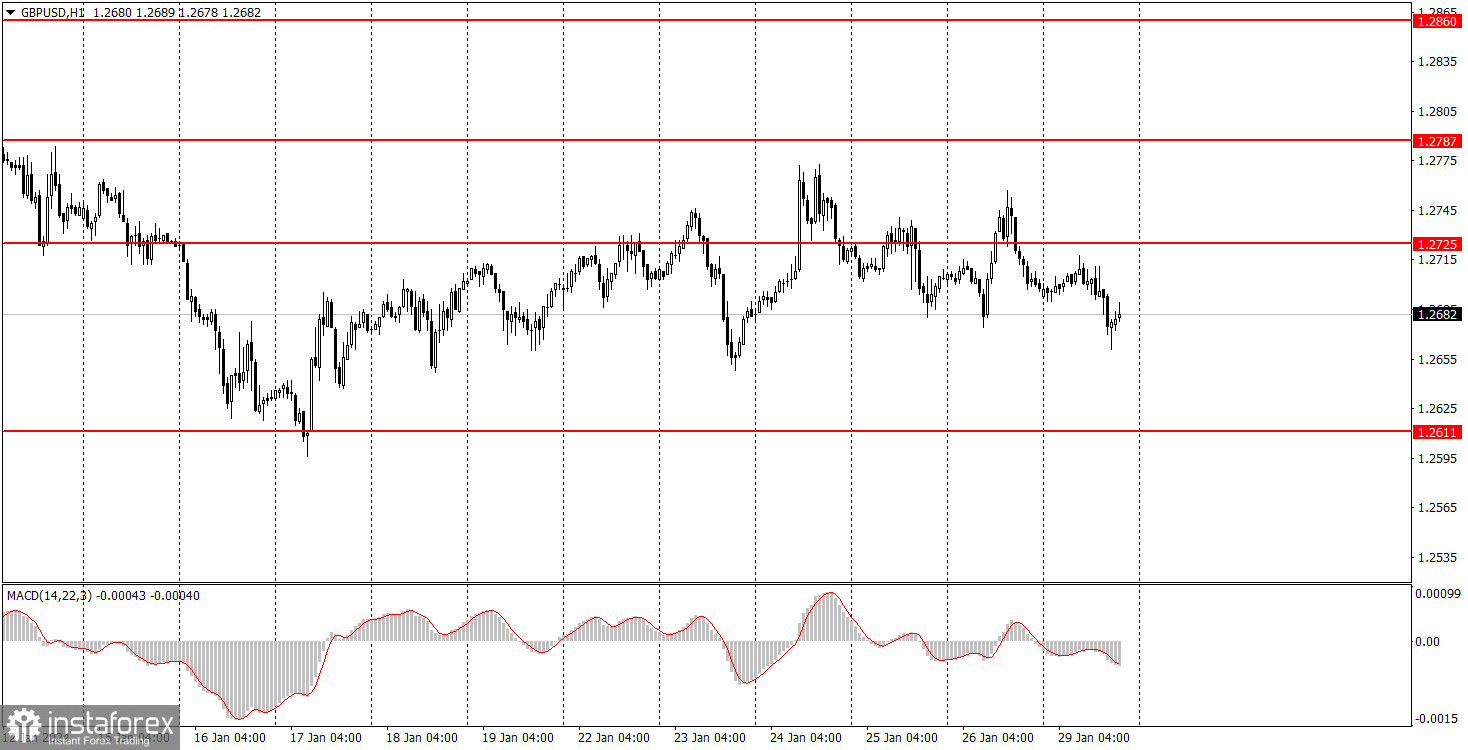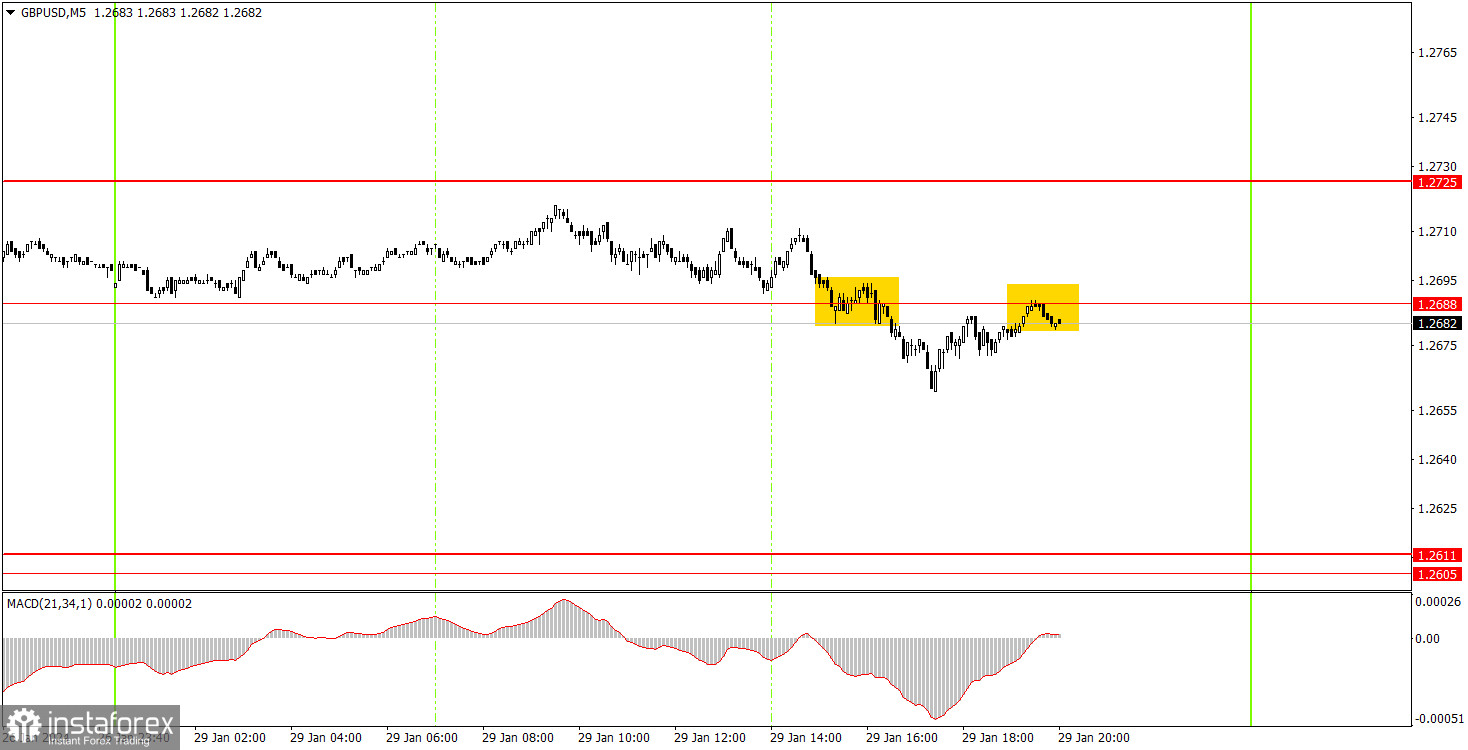Analyzing Monday's trades:
GBP/USD on 1H chart

GBP/USD moved predominantly lower on Monday, still trading within the sideways channel of 1.2611-1.2787. There was no macroeconomic and fundamental background, which explains why volatility was low throughout the day. Also, it was a Monday, and we often observe weak movements on Mondays.
In general, there is nothing to add except that the pair has remained in a flat phase for a month and a half. Of course, this week there will be fundamental and macroeconomic events that could pull it out of the sideways channel, but it won't happen on Tuesday. Therefore, we expect the pair to show the same mixed movements with frequent changes in direction.
The pound has spent the last month and a half near its five-month highs, so it should have started falling by now. However, the price has failed to settle below the level of 1.2611 five times already. As long as the price does not overcome this level, there is no need to dream about further downward movement. So the flat persists for now.
GBP/USD on 5M chart

The movements on the 5-minute timeframe were not the best. The price initially surpassed the level of 1.2688 and then returned to it, and at the moment, it has not yet formed a signal around this level. Thus, there was only one signal on Monday. The price moved in the intended direction after its formation only by 15 pips, but it failed to consolidate above the level of 1.2688, so the short position should have been closed manually anywhere. Traders could not achieve any profit or loss on this trade. Volatility was quite weak.
Trading tips on Tuesday:
On the hourly chart, GBP/USD is still trading within the sideways channel of 1.2611-1.2787. The price bounced off the level of 1.2611 five times, and after the last bounce, a new uptrend has started within the flat. The pair has not yet reached the upper boundary of the channel, and now it is in the middle of the sideways channel. Therefore, the pair could move in any direction.
The British pound will likely remain within the sideways channel. There are hardly any important events, and the price needs to move at least 65 pips to the nearest boundary of the channel. Then it needs to move at least another 20-30 pips in the same direction in order to overcome it. It is hard to believe that this could happen when the current volatility is low. It is also challenging to predict exactly how the flat will end on Tuesday.
The key levels on the 5M chart are 1.2270, 1.2310, 1.2372-1.2387, 1.2457, 1.2502, 1.2544, 1.2605-1.2611, 1.2688, 1.2725, 1.2787-1.2791, 1.2848-1.2860, 1.2913, 1.2981-1.2993. On Tuesday, there are no important events scheduled in the UK. The US will only release a JOLTs report on job openings. Therefore, the pair will likely remain within the sideways channel, but we have to warn you that flats often end abruptly and unexpectedly when nothing foreshadows it.
Basic trading rules:
1) Signal strength is determined by the time taken for its formation (either a bounce or level breach). A shorter formation time indicates a stronger signal.
2) If two or more trades around a certain level are initiated based on false signals, subsequent signals from that level should be disregarded.
3) In a flat market, any currency pair can produce multiple false signals or none at all. In any case, the flat trend is not the best condition for trading.
4) Trading activities are confined between the onset of the European session and mid-way through the U.S. session, after which all open trades should be manually closed.
5) On the 30-minute timeframe, trades based on MACD signals are only advisable amidst substantial volatility and an established trend, confirmed either by a trendline or trend channel.
6) If two levels lie closely together (ranging from 5 to 15 pips apart), they should be considered as a support or resistance zone.
How to read charts:
Support and Resistance price levels can serve as targets when buying or selling. You can place Take Profit levels near them.
Red lines represent channels or trend lines, depicting the current market trend and indicating the preferable trading direction.
The MACD(14,22,3) indicator, encompassing both the histogram and signal line, acts as an auxiliary tool and can also be used as a signal source.
Significant speeches and reports (always noted in the news calendar) can profoundly influence the price dynamics. Hence, trading during their release calls for heightened caution. It may be reasonable to exit the market to prevent abrupt price reversals against the prevailing trend.
Beginners should always remember that not every trade will yield profit. Establishing a clear strategy coupled with sound money management is the cornerstone of sustained trading success.
 English
English 
 Русский
Русский Bahasa Indonesia
Bahasa Indonesia Bahasa Malay
Bahasa Malay ไทย
ไทย Español
Español Deutsch
Deutsch Български
Български Français
Français Tiếng Việt
Tiếng Việt 中文
中文 বাংলা
বাংলা हिन्दी
हिन्दी Čeština
Čeština Українська
Українська Română
Română

